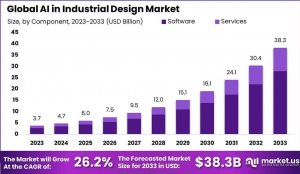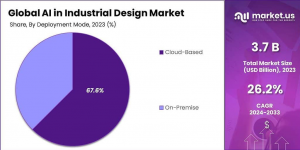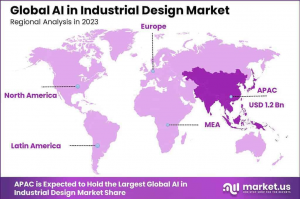The AI in Industrial Design market is estimated to reach USD 38.3 Billion by 2033, with a strong CAGR of 26.2% throughout the forecast period.
In 2023, the Asia-Pacific (APAC) region held a dominant position in the AI in Industrial Design market, capturing more than a 34.7% share with revenue amounting to approximately USD 1.2 billion.”
NEW YORK, NY, UNITED STATES, January 22, 2025 /EINPresswire.com/ -- The AI in Industrial Design market is undergoing significant growth, propelled by various factors including rapid digital transformation and the escalating demand for personalized products. Businesses across industries are integrating AI into their design processes to boost efficiency and spur innovation, particularly in sectors such as automotive and aerospace. — Tajammul Pangarkar
This integration helps in shortening design cycles and enhancing product performance. Moreover, AI's capabilities are continuously enhanced by advancements in algorithms and machine learning, allowing for sophisticated design capabilities like predictive design and real-time problem-solving. This technological evolution is also supported by a growing emphasis on sustainability, with AI helping to optimize the use of materials and reduce waste during the design phase.
In terms of market trends, AI-driven generative design is gaining traction, providing designers with numerous iterations to optimize performance, cost, and material use. Additionally, the use of AI in robotic process automation (RPA) for automating repetitive tasks in the design process not only saves time but also enhances precision. The shift towards cloud-based AI design tools is making collaboration among global teams more feasible, reflecting a dynamic and responsive approach to industrial design.
Access Exclusive Data and Premium Insights at Discounts Here @ https://market.us/purchase-report/?report_id=119531
According to a recent survey, the Industrial Design Market is projected to grow from USD 48.72 billion in 2023 to USD 77.86 billion by 2033, registering a CAGR of 4.8%. This growth is fueled by increasing demand for innovative designs that blend functionality with aesthetics to meet evolving consumer expectations. Over 40% of executives are leveraging AI to boost speed, efficiency, and minimize product failures in design and engineering, highlighting AI's transformative role. Moreover, user-friendly designs have a 300% higher success rate, emphasizing the need for intuitive solutions to unlock AI's full potential in product development
The demand in the AI in Industrial Design market is robust, with significant growth potential in the Asia-Pacific region, which currently dominates the market. This region's growth is largely due to substantial investments in digital transformation initiatives by major manufacturing countries like China, Japan, and South Korea, which are integrating AI technologies to improve design precision and reduce product development cycles. Additionally, government support for adopting advanced technologies and the rise in demand for customized, consumer-specific products are contributing to market expansion in this region.
Key Takeaways
The AI in Industrial Design market is projected to grow significantly, reaching USD 38.3 billion by 2033, fueled by an impressive compound annual growth rate (CAGR) of 26.2% during the forecast period.
In 2023, the software segment emerged as a key player, holding a dominant share of 72.7%. This reflects the increasing reliance on AI-powered software tools for design processes across various industries.
The cloud-based solutions segment also took the lead in 2023, capturing a market share of 67.6%. This trend highlights the growing preference for scalable and accessible cloud platforms among design professionals.
Within the application sectors, the automotive industry stood out, contributing to 33.7% of the total market share in 2023. This dominance is driven by the industry's rapid adoption of AI to enhance product design and innovation.
Regionally, Asia-Pacific was the market leader in 2023, accounting for a substantial 34.7% share. This growth is attributed to the presence of major tech companies and a strong focus on R&D investments in countries like China, Japan, and South Korea.
Unlock Growth Potential in Your Industry - Get Your Sample Report Now: https://market.us/report/ai-in-industrial-design-market/request-sample/
Analysts’ Viewpoint regarding AI in Industrial Design Market
Investment in AI-driven software solutions is pivotal, as they facilitate complex simulations and optimize design processes, thereby significantly boosting productivity and innovation. The cloud-based deployment of AI tools further underscores their utility, offering scalable and flexible solutions that are ideal for contemporary industrial design needs. However, the market faces hurdles such as high implementation costs and a scarcity of skilled professionals, which could slow down the adoption rate of AI technologies.
Technologically, AI is making strides in predictive maintenance and enhancing operational efficiency across manufacturing sectors. Machine learning and computer vision are at the forefront, improving fault detection and predictive analytics, thus minimizing downtime and extending machinery life. Furthermore, extended reality (XR) and biophilic design trends are gaining traction, enhancing user interaction with 3D models and integrating natural elements into designs, respectively, which reflects growing consumer preferences for sustainable and user-friendly products.
Regulatory environments also play a crucial role, as they need to evolve to support the innovative changes brought on by AI while ensuring data privacy and system security. As AI technologies continue to advance, they promise to bring more personalized, efficient, and sustainable design solutions to the forefront of industrial applications, ultimately fostering a competitive market driven by innovation and efficiency.
Who is Investing in AI in Industrial Design market?
Several major companies are actively investing in the AI in Industrial Design market, recognizing the potential to revolutionize product development and design processes. Key players include:
Autodesk Inc. - A leader in the design software industry, Autodesk integrates AI into its tools like Fusion 360, which assists designers in generating optimized designs and simulating real-world scenarios.
Dassault Systèmes SE - Known for its software systems to support manufacturing and design, Dassault Systèmes incorporates AI to enhance productivity and creativity in industrial design.
Siemens AG - This industrial giant invests in AI for a range of applications, including industrial design, to improve automation and precision in product development.
NVIDIA Corporation - As a major player in AI and computing, NVIDIA provides AI platforms that support complex design tasks and data analysis for industrial design.
Infosys - Through its Infosys Topaz platform, it leverages AI to provide cognitive solutions that enhance efficiency and value creation in industrial design.
Report Segmentation
Component Analysis
The software segment proved to be the powerhouse of the AI in Industrial Design market, capturing over 72.7% of the market share. This dominant position is fueled by the essential role that software plays in the operational deployment of AI technologies in industrial design. AI-driven software solutions are crucial for implementing machine learning, neural networks, and computer-aided design systems, which are vital for automating design processes and enhancing productivity and innovation. The continuous advancement in AI software capabilities contributes to more accurate and faster design outcomes, ensuring that the software segment retains a central role in the market.
Deployment Mode Analysis
Cloud-based solutions led the deployment modes with more than 67.6% of the market share. The scalability and flexibility of cloud computing platforms make them ideal for modern industrial design needs. They enable efficient data management, enhanced collaboration among dispersed teams, and access to advanced AI tools and resources without heavy initial investments in infrastructure. The global shift toward remote work environments has also played a critical role in accelerating the adoption of cloud technologies.
Industry Vertical Analysis
The automotive sector stood out in the industry verticals, holding over 33.7% of the market share. The integration of AI technologies has been transformative in automotive design and manufacturing, driving efficiencies and innovation. AI applications in this sector facilitate more precise simulations and the automation of routine tasks, which streamline the design process and enhance product quality. The push towards electric vehicles and autonomous driving technologies further strengthens AI's role in automotive design.
Need expert consultation around identifying, analysing and creating a plan to mitigate risks related to your business? Share your concerns and queries, we can help at https://market.us/book-appointment/?report_id=119531
Regional Analysis
In 2023, the Asia-Pacific region emerged as a powerhouse in the Artificial Intelligence (AI) in Industrial Design market, commanding an impressive 34.7% share. This translates to a robust revenue of approximately USD 1.2 billion, underscoring the region's pivotal role in this technological sector. Several factors contribute to APAC's leading position, making it a focal point for market analysts and industry stakeholders.
Firstly, the Asia-Pacific region benefits from a significant concentration of manufacturing hubs that have increasingly integrated AI technologies to optimize design processes and enhance production efficiency. Countries like China, Japan, and South Korea are at the forefront, employing AI solutions in automotive, electronics, and consumer goods industries. This adoption is driven by the availability of substantial industrial bases and government support aimed at advancing manufacturing capabilities through technology.
Furthermore, APAC's dominance in the AI in Industrial Design market is bolstered by its robust ecosystem of tech startups and established tech giants that invest heavily in AI research and development. The region has seen a surge in innovation centers and R&D investments from multinational corporations aiming to tap into local talent and technological advancements. This has led to the development of cutting-edge AI solutions tailored to industrial design needs, positioning APAC as a leader in both innovation and application of AI technologies.
Driver: AI-Driven Efficiency and Innovation in Industrial Design
Artificial Intelligence (AI) significantly enhances industrial design by driving efficiency and fostering innovation, particularly within the context of Industry 4.0. This technological shift leverages advanced automation and data analysis, transforming traditional manufacturing processes. AI tools like machine learning and deep learning optimize everything from production lines to product design, enabling real-time adjustments and predictive maintenance.
This results in streamlined operations and reduced downtime, directly improving productivity and cost-effectiveness. The integration of AI in industrial design not only refines existing products but also accelerates the development of new ones through rapid prototyping and generative design techniques, pushing the boundaries of what can be achieved in product development.
Restraint: Ethical and Regulatory Challenges
Despite its vast potential, the integration of AI in industrial design is restrained by significant ethical and regulatory challenges. Issues such as data privacy, security, and the potential for bias in AI algorithms pose serious concerns. The opacity of some AI systems, which makes their decisions difficult to interpret, further complicates regulatory approvals and ethical acceptability. Companies must navigate a complex landscape of international standards and regulations, which can vary widely by region and often lag behind technological advancements, complicating global operations. Addressing these ethical concerns requires robust frameworks and continuous reassessment of AI applications to ensure they meet evolving standards of fairness, transparency, and accountability.
Opportunity: Market Expansion and Customization
AI opens up vast opportunities for market expansion in industrial design by enabling more personalized and customer-focused product offerings. AI's capability to analyze large datasets allows companies to identify and anticipate customer preferences and market trends, leading to the design of tailored products. Additionally, AI facilitates the exploration of new materials and production techniques, thereby expanding the range of possible product offerings.
This not only enhances customer satisfaction but also allows companies to tap into niche markets that were previously inaccessible due to traditional manufacturing constraints. The ability to rapidly adjust production processes and product designs in response to market feedback is a key competitive advantage in today's fast-paced market environments.
Challenge: Skill Gap and Technological Complexity
One of the primary challenges in harnessing AI within industrial design is the significant skill gap and the technological complexity involved. The successful implementation of AI requires a workforce that is proficient not only in traditional design principles but also in sophisticated AI technologies and data analysis techniques. However, there is currently a shortage of professionals who possess these hybrid skills.
Moreover, the complexity of AI systems themselves can be a barrier, particularly for small to medium enterprises (SMEs) that may lack the resources to invest in such technologies. Organizations must invest in training and development programs to build AI competence within their existing workforce and consider partnerships with tech firms to bridge these gaps.
Top Key Players Covered
- Autodesk Inc.
- Dassault Systèmes SE
- Siemens AG
- NVIDIA Corporation
- PTC Inc.
- Ansys Inc.
- Hexagon AB
- Altair Engineering Inc.
- Bentley Systems Incorporated
- MathWorks
- Other Key Players
Conclusion
The AI in Industrial Design market is poised for significant growth, driven by a suite of transformative factors. Digital transformation, increased demand for customization, and continuous advancements in AI and machine learning are pivotal in enhancing design processes across industries. The integration of AI not only streamlines product development cycles but also fosters innovation by enabling predictive design and real-time problem-solving.
Regional growth is especially notable in the Asia-Pacific, supported by strong manufacturing sectors and governmental initiatives promoting technology integration. As businesses continue to leverage AI for more sustainable, efficient, and customized design solutions, the market outlook remains robust and expansive, signaling a dynamic era for industrial design shaped by cutting-edge technological integration.
Explore More Reports:
EdTech Market - https://market.us/report/edtech-market/
Business Process Outsourcing Market - https://market.us/report/business-process-outsourcing-market/
Esports Market - https://market.us/report/esports-market/
Semiconductor Market - https://market.us/report/semiconductor-market/
Drone Market - https://market.us/report/drone-market/
Smart Homes Market - https://market.us/report/smart-homes-market/
Lawrence John
Prudour
+ +91 91308 55334
Lawrence@prudour.com
Visit us on social media:
Facebook
LinkedIn
Legal Disclaimer:
EIN Presswire provides this news content "as is" without warranty of any kind. We do not accept any responsibility or liability for the accuracy, content, images, videos, licenses, completeness, legality, or reliability of the information contained in this article. If you have any complaints or copyright issues related to this article, kindly contact the author above.




